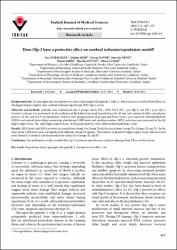Does Glp-2 have a protective effect on cerebral ischemia/reperfusion model?

View/
Access
info:eu-repo/semantics/openAccessDate
2015Author
Topaloğlu, NaciMemi, Gülsün
Kaner, Tuncay
Deniz, Mustafa
Şahin, Önder
Güven, Mustafa
Coşar, Murat
Metadata
Show full item recordAbstract
Background/aim: To investigate the neuroprotective effects of glucagon-like peptide 2 (Glp-2), which increases cerebral blood flow, on the hippocampal complex after cerebral ischemia/reperfusion (I/R) injury in rats. Materials and methods: Animals were randomized into 4 groups: sham, I/R + 0.9% NaCl, I/R + pre-Glp-2, and I/R + post-Glp-2. Cerebral ischemia was performed via the occlusion of the bilateral internal carotid artery for 40 min and continued with a reperfusion process. At the end of 6 h of reperfusion, animals were decapitated in all groups and brain tissues were removed. Malondialdehyde (MDA) and natural intracellular antioxidant glutathione (GSH) levels and myeloperoxidase (MPO) activities were measured in the left hippocampal tissue. The right hippocampal tissues of all group members were taken for histopathologic study. Results: MDA levels and MPO activities increased from Group I to Group II and decreased from Group II to Groups III and IV. On the other hand, GSH levels were not significantly different among the groups. The number of apoptotic hippocampal tissue cells increased from Group I to Group II and decreased from Group II to Groups III and IV. Conclusion: Our preliminary study revealed that Glp-2 treatment may decrease oxidative damage from I/R in cerebral tissue.


















